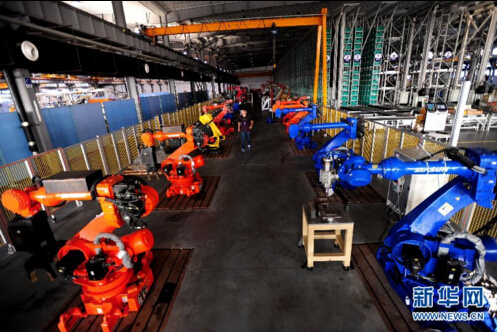China's robot industry lacks core technology
- By Lin Liyao
 0 Comment(s)
0 Comment(s) Print
Print E-mail China.org.cn, April 7, 2016
E-mail China.org.cn, April 7, 2016
In recent years, due to rising labor costs and rapid industrial transformation, a number of Chinese factories have become eager to replace workers with automated equipment. To meet their needs, the Chinese government has vowed to promote industrial robotics as well as high-speed and high-performance controllers and other key components with its 13th five-year plan.
|
A production line at the Siasun Robot & Automation Co., Ltd. uses robots to make robots. [Xinhua] |
In 2015, China's first industrial robot production line commenced operation at the Siasun Robot & Automation Co., Ltd. in Shenyang, Liaoning Province, which is used to produce components for a new model of BMW automobiles. The company marks the first Chinese robot brand to produce stamping accessories for an international, high-end auto enterprise in the country.
The Siasun robot company currently sells more than 1,000 industrial robot units each year. The types of robots include welding, polishing, buffing, stacking, coating and stamping, which are able to provide systematic services for the auto, electronic, electric power, food and medical industries.
In 2015, the company's revenue reached 518 million yuan (US$80 million), which was an increase of 8.63 percent year-on-year, with a gross profit rate of 33.74 percent.
Despite beginning in 2013, China has become the world's largest industrial robot market; the production density of the industry is still very low. In 2013, 10,000 Chinese workers can only produce 30 industrial robot units, less than half of the world's average level. In South Korea, every 10,000 workers can produce 437 industrial robot units. In Japan, the number is 323 and in Germany, the number is 282.
What's worse is that most of the Chinese robot factories suffer poor operating conditions.
In the past two years, the number of robot companies in China reached almost 1,000. According to the statistical data of the OFweek Industry Research Center, during the first half of 2015, over 80 percent of these robot companies increased their business volume, but more than 70 percent of them suffered huge deficits.
The statistics of the International Federation of Robotics (IFR) showed that in 2014, there were five major markets representing 70 percent of the total sales volume, notably China, Japan, the United States, South Korea and Germany.
There were 57,096 industrial robot units sold in 2014 in China, up 56 percent from 2013. Chinese robot suppliers installed roughly 16,000 units, according to the information from the China Robot Industry Alliance (CRIA). Their sales volume was about 78 percent higher than it was in 2013. Meanwhile, foreign robot suppliers have increased their sales to 41,100 units, up by 49 percent year-on-year.







Go to Forum >>0 Comment(s)